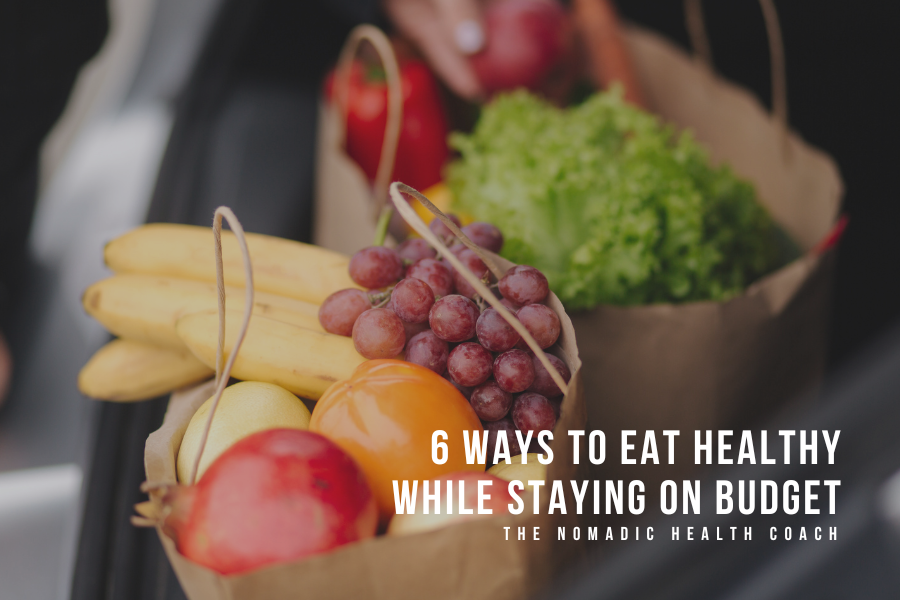Stay on budget while also eating healthy.
IMHO the foundation for good health is comprised of two main ingredients; the kitchen and the market. It’s easy to go over budget with the second ingredient, the market, if we aren’t paying close enough attention to the first ingredient, the kitchen.
Being successful with staying on budget at the market begins at home. Follow my 6 tips below and learn to eat and shop healthy while staying on your budget.
1. Clean Your Fridge:
How often do you clean out your fridge? I’ll bet the answer to that is “not often”! Many folks have items in their fridge with expiry dates going back several years. Don’t believe me? Go check your condiments in the door. A weekly practice of cleaning and organizing your fridge is one of the best ways to stay on budget. Many times we come home from the market with an item we already have and sometimes these items have a high price tag.
The best time to do this is within two days of heading to the market as you will have a clear memory of what you may need and what you already have. To do this initially, and to keep it from being a huge project, start with one shelf or one drawer and spread it out over a few days or several weeks. I can guarantee you that once this is complete it will be much easier to keep up with on a weekly basis.
- Remove every item from the shelf/drawer/section
- Wipe down shelf/drawer/section with warm soapy water and dry off (no chemicals or sprays please!)
- Check expiry dates on all items
- Rinse and recycle, or toss all expired items
- Clean the items you are keeping and return them to the shelves
- Organize as you see fit.
It can also be helpful to make a list of the foods and condiments you are keeping while you are cleaning. This will make your meal planning easier which will make your market trip more efficient.
A clean fridge is a healthy fridge!
2. Take Notes:
Every smartphone has a reminder or notes app or one is available at your app store. Create categories based on the market sections and when you deplete an often-used item during the week, add it to your list and category immediately. You will always have up-to-date info which will prevent you from either double-buying an item or forgetting it altogether. This also helps with impromptu trips to the market!
Your reminders should look like something like this:
- Produce Department
- Apples
- Spinach
- Kale
- Tomatoes
- Strawberries
- Meat Department
- Fresh Salmon
- Grass-fed beef
- Organic chicken
- Dairy
- Oatmilk
- Pasture-raised eggs
- Manchego cheese
- Other
- Kombucha
- Jasmine rice
- Green tea
Check it off when you’ve put it in your cart! As you deplete during the week add items back to the list.
3. Take Inventory First: Pantry, fridge and freezer.
This should be done weekly and always before a trip to the market. Organize shelves and make a list of what’s on hand. As above, check the expiry date and toss if need be. Use the items for inspiration for your weekly meal planning. I like to pretend I’m on an episode of The Food Channels Chopped! to create new dishes with what I have on hand and use up what’s left.
4. Plan Your Menu
Now that you’ve taken inventory, search or plan for recipes that use some of the ingredients you already have on hand. Choose at least four recipes that can be used as main dishes. And when planning your recipes, consider if you want leftovers to eat throughout the week. Plan your recipes around the seasons and the sales at the market (check their app or website for sales before heading out).
Here are some of my favorite websites and also a recipe manager that I have been using for over a decade that you may love:
Don’t forget to add the recipe ingredients to your reminder app!
Go Bulk!
The bulk section at most co-ops and natural markets allows you to buy as much or as little as you need – saving your money and reducing waste. Bring your measuring cups if you are following a specific recipe so as to not over-purchase. You can find legumes, flours, spices, quinoa, rice, nuts, seeds, and so much more in the bulk aisle.
- Grinding your own peanut or almond butter is a great way to eat healthier and stay on budget.
- Bring your own container! The additional cost of a new container can add up quickly and creates more waste.
- Save dollars by purchasing dried beans and legumes. They last a long time in the fridge so cook up a large batch and eat throughout the week in several different recipes such as soup, stews, salads, tacos, etc.
- Ask customer service to repackage dried fruit in a smaller package for you.
6. Shopping The Market
For optimal health, shop the perimeter of the market and avoid the bakery area unless you are buying fresh artisan bread.
- Shop for produce using the EWG’s Dirty 12 Clean 15 list to minimize exposure to toxic pesticides.
- Avoid processed and pre-packaged meals as they are loaded with salt and unpronounceable ingredients that deter our health goals. They are also expensive.
- Make sure you’ve eaten something before you shop as we ALWAYS over purchase when we are hungry!
- Food waste is the biggest strain on our wallets. Ask produce staff to cut large fruits or vegetables like cabbage, melons, celery, and cauliflower into more manageable and affordable pieces. Many produce items are sold per pound so if the bag of grapes is more than you can afford—or you will be able to eat before they go bad—take some out and add to the bag next to it. You can do this with almost any item that is loosely packaged and sold by the pound.
- Don’t buy more than you need! Use the scale to estimate the cost before you buy (think grapes!) or to get the exact amount your recipe calls for.
- Inspect your produce and don’t put anything in your cart that is blemished, bruised or dinged.
- Treat stone fruit as gently as you would eggs to prevent bruising.
Once you get home use my two guides washing produce and storing produce to make your dollars stretch as far as possible and avoid waste.
Use up all of what’s in your fridge and aim to never throw away food. Master omelets, stir-fries, tacos, pasta sauces—all of these require no recipe and can contain any fusion of ingredients. Maybe try your own take on Chopped! and create a new recipe masterpiece!
Your goal is to have a nearly empty fridge before heading to the market. This will keep the cleaning easier, your food fresher, and the dollars in your pocket.





3 Comments
Also, I’m really loving to read what you wrote on eating healthy, on budget & stating on top of refrigerator cleaning & using items. Also learning good things as I read about your cleaning & storing processes for produce!
Dear Lorri, You are inspiring me & bringing some hopeful thoughts. I’ve been deeply afflicted with grief after losing my dearest loved ones & also had to relocate several times. The shock, trauma, loneliness hit hard, but you inspire me because you are moving on & using your gifts to make a difference! I’ve thought about living out of a motor vehicle home also. Maybe? God bless you & thanks for shining some light on a possible path!!
Hello Kathy – thanks for your comment. I am very sorry for your loss and hope you are managing your grief as well as possible. It is a journey for sure. I’m happy I have inspired you a bit and offered some hope for your future. You could totally do this!!